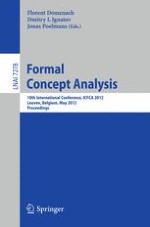2012 | Book
Formal Concept Analysis
10th International Conference, ICFCA 2012, Leuven, Belgium, May 7-10, 2012. Proceedings
Editors: Florent Domenach, Dmitry I. Ignatov, Jonas Poelmans
Publisher: Springer Berlin Heidelberg
Book Series : Lecture Notes in Computer Science
